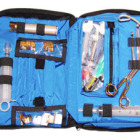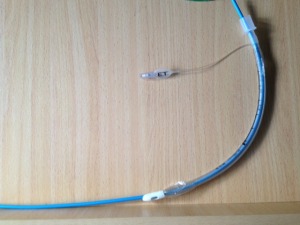
Oct 1, 2014
Over the years, we have talked a bit about intubation. We have talked about whether we should be doing it, and more recently, we made an argument to reinstitute studies on success rates based on our technological advances. As I have stated before, I am far from an “airway guru.” I am an average intubator, but I feel that I am successful more times than not because of the process that I use, and some of the pieces advice that I have gotten over the years. Since we just recently talked about some finer points of intubation, I thought now would be a good time to share a few key pieces of advice that I have gotten over the past fourteen years.
1. Use the smallest blade possible – Like many paramedics, my “go to” blade has been the Mac 4 since I was in paramedic school. I always felt that bigger was better because if I did not need quite so much blade, I could always pull out just a bit. If I decided to go right at the epiglottis and pick it up instead of shooting for the valecula, I could do that too. That remained true until I watched this video:
Using the smallest blade possible means that you do not work as hard to visualize the cords. It makes sense, and more importantly it works. In the last couple of months I have been using a Mac 3 more and more, and I find intubation considerably easier as a result.
2. Elevate the head – In more difficult intubations, the first thing that I do is elevate the head. While lifting the blade with my left hand, I put my right hand under the patient’s head and pick it up by an inch or two. I find this is extremely effective when trying to bring the axises of the airway into alignment. The downside is I end up needing a second set of hands to get the patient intubated, however with the number of people that we have on cardiac arrests, I usually have someone on airway with me anyway.
3. Develop a process – As I stated in a previous post, my partner has gotten back to basics and talks her way through every single intubation she does to hep make sure that she is doing it the same way every single time. There is probably no bigger point to remember than to be consistent. As part of that process, make sure that you have all of the tools that you might need handy. this includes suction, an intubating stilette, and whatever confirmation means your department uses. We are a field that thrives on consistency in the way we work, the way we start IV’s, pretty much the way we do everything. Intubation is no exception.
4. Use a bougie every single time – In my system, if a patient is not a “Grade 1” airway, we are required to take out the bougie and pass it before passing a tube over it. Prior to coming to my new job, I had used a bougie only a couple of times. I was successful with it, however it was often an afterthought as I relied on pure muscle, experience, and visual landmarks. Passing an intubating stylete like the bougie is much easier than trying to jam a tube home in a difficult to visualize airway.
5. Know when enough is enough – We are going to run into airways that are more difficult than we are capable of handling for one reason or another. I have said before that we need to be humble incubators, and this goes right along with that. There will be those times when you have to pass the blade to your partner or just put it away all together. Keep those backup devices close by and make sure that you are comfortable managing an airway with an OPA, NPA, and BVM.
There is one last thing that I would like to mention. I cannot for the life of me, at this point in the development of medical equipment, figure out why any system would utilize laryngoscope blades that are not disposable. I understand the desire to stay away from them fifteen years ago when the vast majority of disposable blades were made with cheap plastic but we have come a long way since then.
For twelve years, after intubating a patient my partner or myself would end up in the utility room of the hospital doing a quick wash on a blade with some disinfectant or soap. There was no policy or procedure for it, it just said that we had to clean it as best we could.
Get with the times, people. Disposable is the only way to go. Companies have made it an affordable option, and far more important than that, it is much safer and more hygienic for our patients.
There are a lot of skills and pieces of equipment that I think EMS could do without. Our intubation kit, however, is not one of them. It is a low volume skill though, and we need to keep every trick that we can think of in our back pocket to help make our intubations go more smoothly. If you are having a tough time, try some of the tips I have listed above, and if you have any tips of your own, please share them in the comments!

